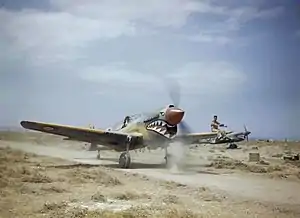The Northwest African Tactical Air Force (NATAF) was a component of the Northwest African Air Forces which itself reported to the Mediterranean Air Command (MAC). These new Allied air force organizations were created at the Casablanca Conference in January 1943 to promote cooperation between the British Royal Air Force (RAF), the American United States Army Air Force (USAAF), and their respective ground and naval forces in the North African and Mediterranean theater of World War II . Created on February 18, 1943, the NATAF and other MAC commands existed until December 10, 1943, when MAC was disbanded and the Mediterranean Allied Air Forces (MAAF) were established.
Acting Air Marshal Sir Arthur Coningham , who had been air officer commanding Western Desert Air Force became the commander of NATAF.[1] and the WDAF became part of the new NATAF
Composition
The components of NATAF at the time of the Allied invasion of Sicily (Operation Husky) on July 10, 1943, are illustrated below.[2][3]




For Operation Husky, No. 242 Group RAF, originally a component of NATAF in February 1943, was assigned to the Northwest African Coastal Air Force (NACAF). At the same time, Air Headquarters, Western Desert became known as Desert Air Force. All of the fighter units of Desert Air Force formed No. 211 (Offensive Fighter) Group commanded by Air Commodore Richard Atcherley on April 11, 1943, in Tripoli. The 99th Fighter Squadron (one of the Tuskegee Airmen units) was assigned to the XII Air Support Command on May 28, 1943, and subsequently attached to the 33rd Fighter Group. The actual squadron assignments and detachments varied throughout the war depending on the specific needs of the air force.
The table above illustrates the squadron assignments and commanders for the important period of World War II when the Allies prepared to invade Italy (Operation Husky), having just won the war in North Africa with the end of the Tunisia Campaign. In recognition of XII Air Support Command's operations in Sicily, Supreme Allied Commander General Dwight D. Eisenhower presented Major General Edwin House with the Legion of Merit and saying that "...for the first time established the application of a tactical air force operating in support of an American Army."[7]
See also
Notes
- ↑ The British and Commonwealth forces used "Kittyhawk" as service name for Curtiss P-40D and later models
- ↑ Dive bomber version of the North American P-51 Mustang fighter/fighter-bomber
- ↑ 244 Wing was commanded by Ian Gleed until he was shot down on 16 April 16 1943 then by W. G. G. Duncan Smith until replaced by Kingcome
- ↑ American designation of the same aircraft as the Boston
- ↑ le Roy du Vivier was a Belgian pilot who joined RAF in 1940
References
- ↑ Craven, Wesley F. and James L. Cate. The Army Air Forces in World War II, Volume 2, Chicago, Illinois: Chicago University Press, 1949 (Reprinted 1983, ISBN 0-912799-03-X).
- ↑ Richards, Dennis; Saunders, Hilary (1954). The Royal Air Force 1939-1945: Volume II The Fight Avails. History of the Second World War. HMSO – via Hyperwar Foundation.
- ↑ Howe, George F., Northwest Africa: Seizing the Initiative in the West, Center of Military History, Washington, DC., 1991.
- ↑ Participation of the Ninth & Twelfth Air Forces in the Sicilian Campaign, Army Air Forces Historical
Study No. 37, Army Air Forces. Historical Office Headquarters, Maxwell AFB, Alabama, 1945. - ↑ Maurer, Maurer, Air Force Combat Units Of World War II, Office of Air Force History, Maxwell AFB, Alabama, 1983.
- ↑ Thomas, Andrew (2013). Spitfire Aces of North Africa and Italy. Bloomsbury Publishing. p. 47. ISBN 9781849083447. Retrieved 15 March 2018.
- ↑ "Biographies : Major General Edwin J. House". Archived from the original on 17 July 2012.